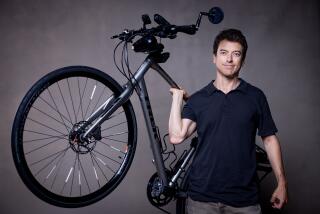Can car-happy L.A. learn to share the road?
September brought sweet victory to the growing community of California cycling advocates: Gov. Jerry Brown signed into law a bill that will prohibit the driver of any motor vehicle from passing a bike rider on the road unless there is 36 inches of space between them. Or, if for some reason that minimal passing distance just isn’t possible, drivers will have to slow to a speed that is “reasonable and prudent.”
The “3-foot rule” seems quite modest. A yard’s worth of pavement between a cruising car or truck and a cyclist, pumping uphill or holding on for dear life on a downward slope, is hardly excessive. Fines are paltry as moving violations go — $35. The law doesn’t even take effect until this fall, giving drivers plenty of time to get used to the idea and cyclists and state officials plenty of time to educate them.
But Brown had vetoed two earlier versions of the bill, leaving the impression that California was stuck in a postwar baby boom world in which streets were meant for automobiles alone. The governor’s turnabout, after his concerns regarding potential state liability were addressed, was a big deal for cyclists, and perhaps a bit irksome to motorists in a state where car culture enjoyed its blissful adolescence and aggressive young adulthood.
VIDEO: Do you drive in L.A.? Watch this to see what scares cyclists.
As the bill was being signed, The Times editorial writers were beginning RoadshareLA, an online exploration of the seemingly sudden arrival of cyclists as not just a cultural but a political force in California. Bicycle advocates, for example, helped promote and pass a law — at just about the time the first 3-foot bill was being run off the road — that requires cities and counties to re-imagine their streets as transportation arteries that accommodate the increasing number of cyclists and pedestrians and de-emphasize cars. The law was designed in part to reduce greenhouse gas emissions, in part to improve road safety, in part to enhance the quality of life in neighborhoods where streets had become commuting-hour freeways, and in part, some argue, to reduce obesity. And, others insist, to keep cities here in competition for young professionals who reject their parents’ car-oriented outlook and want to live and work in cities that accommodate their car-free lifestyles.
Assembly Bill 1358, known as the Complete Streets Bill, brought to California a nationwide revolution in how we think about our streets, how they’re engineered and how they’re ultimately used. Los Angeles has begun to notice some of the effects of that law, not just in the number of bike lanes and cyclists who use them but in “road diets” that remove automobile lanes.
Those lane changes may enhance some communities and protect the safety of cyclists. But they also affect the commuting patterns — and needs — of a city laid out for drivers. Consider the 2nd Street tunnel, an east-west passage between downtown and the rest of the city, and an iconic location featured in countless Hollywood chase scenes and car commercials. It’s now in part a bike path, with one less car lane in each direction. Has that change added five or 10 minutes — and untold spewing pollutants from idling cars — to the twice-daily downtown commute? How well are we thinking through such changes? Are cyclists and drivers sharing the road, or are they locked in a struggle for street hegemony?
VIDEO: Do you bike in L.A.? Watch this to see what concerns all those drivers.
Until now, cycling advocates and transportation planners have responded to complaints about road diets and slower car traffic by pointing out that restriping is relatively cheap. “It’s just paint,” they said, and can be scraped off if the new traffic patterns prove undesirable.
But Los Angeles is now preparing its first truly “complete street,” on Figueroa, creating bike lanes separated from car traffic by concrete curbs. Road diets will no longer be temporary. It’s no longer just paint.
RoadshareLA looked at how other cities handle the interaction between cyclists and drivers, including London and New York. This week RoadshareLA concludes with a look back at lessons learned from the discussion, and forward, seeking an agenda for divvying up the asphalt. Readers can follow and join the conversation at latimes.com/roadshare and #roadshareLA. And they can view two videos — one each from the cyclists’ and drivers’ point of view — that present the challenges facing all Angelenos who try to share the road.
This is part of an ongoing conversation to explore how the city’s cyclists, drivers and pedestrians share and compete for road space, and to consider policy choices that keep people safe and traffic flowing. For more: latimes.com/roadshare and #roadshareLA.
More to Read
A cure for the common opinion
Get thought-provoking perspectives with our weekly newsletter.
You may occasionally receive promotional content from the Los Angeles Times.










